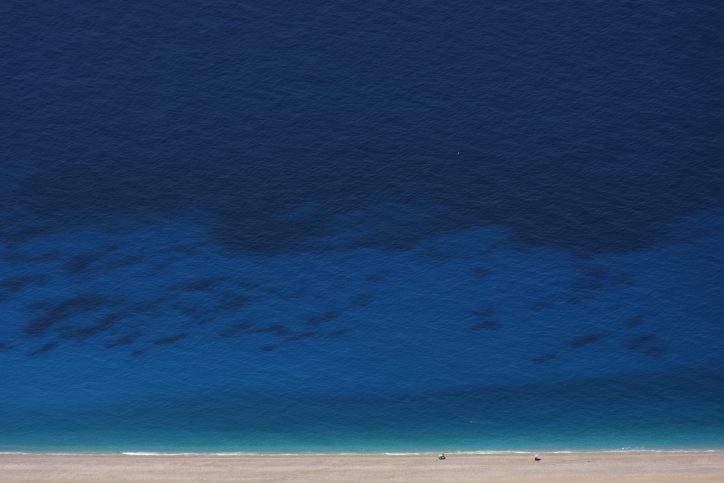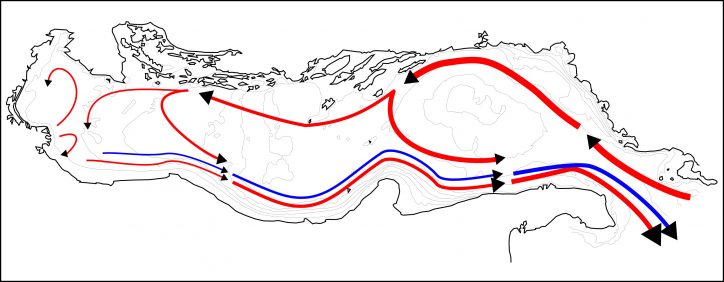Although one can get general information about the Adriatic Sea from many sources, it would be embarrassing for adriaticnature not to make a brief review concerning this topic.
The Adriatic is a semi-enclosed sea, a part of the Mediterranean Sea. It is located between the Apennine and Balkan peninsulas. It bounds Italy (1,250 km), Slovenia (47 km), Croatia (1,774 km), Bosnia and Herzegovina (21 km), Montenegro (249 km) and Albania (396 km). The width of the sea varies from 93 to 222 kilometers.

(Adriatic sea near the city Palasë, Albania. Photo by © adriaticnature)
In the southeast, the Adriatic Sea merges into the Ionian Sea through the Strait of Otranto. The boundary between the Adriatic and Ionian Seas can be depicted as an imaginary line running from the debouchement of the Vivari Channel, also called the Butrinto River in Albania, situated close to the border with Greece, to Cape Karagol on Corfu Island and, across the island, to Cape Kephali on the other extreme end of the island, and to Cape Santa Maria di Leuca in Italy.
The Adriatic Sea occupies the area of 144 thousand sq. km. It is geographically divided into the Northern Adriatic, Central (or Middle) Adriatic and Southern Adriatic. The northern part is the shallowest, the depths rarely exceed 100 meters, the southern part is the deepest one, with a maximum depth of 1,233 meters. The average depth of the Adriatic Sea is 259.5 meters.

(Adriatic Sea, Montenegro. Photo by © adriaticnature)
More than 1,300 islands are scattered in the Adriatic Sea. They are located mainly along the east coast of Croatia. Krk, Cres, Brač, Hvar, Pag and Korčula are the largest ones.
Salinity of the Adriatic is lower than salinity of the Mediterranean Sea in its entirety because the Adriatic Sea amasses a third of all the fresh water of rivers running into the Mediterranean Sea. The main rivers are as follows: Po, Soča, Krka, Neretva, Drin, Bojana and Vjosë. Beside the rivers, falling into the sea, numerous underground springs, which emerge on the seabed, feed the sea as well. According to scientists, they supply 29% of the total inflow of freshwater to the Adriatic Sea.
The water surface temperature varies from 12-14 °C in winter to 22-30 °C in summer. In the northern part of the western coast of the Adriatic Sea, the water temperature can fall to 9 °C in winter.

(Bay of Kotor, Montenegro. Photo by © adriaticnature)
The climate has Mediterranean features, but it differs from the climate of the Mediterranean Sea in general. Local winds, including bora, mistral, sirocco, influencing the atmospheric temperature, are typical for this area. Bora and sirocco (called bura and jugo on the east coast correspondingly) are the prevailing winter winds. Bora brings cold and dry continental air, the wind reaches maximum speed in the areas of the cities of Trieste (Italy), Senj and Split (Croatia) with gusts of up to 50 meters a second. Sirocco brings humid and warm air, often with sand from the Sahara desert, falling to the ground, when it rains.
In summer, fair weather with strongly pronounced breezes, which are rarely changed to storms, prevails on the shores of the Adriatic Sea. Winter is cloudy and rainy (up to 70% of annual precipitation falls).
Tides in the Adriatic Sea are mostly negligible, water fluctuations reach up to 1.4 meters, more often they are about 30 centimeters.

(The main currents in the Adriatic Sea. Picture by en.wikipedia.org)
It is estimated that the total water volume of the Adriatic Sea is renewed through the Strait of Otranto in the course of 3.4±0.4 years, which is a relatively short period of time (for example, it takes about 500 years to renew the total water volume of the Black Sea).
About 450 fish species inhabit the Adriatic Sea. Some of them are several centimeters long, and some species grow up to several meters. adriaticnature will reveal information about all the Adriatic representatives of the favorite superclass of aquatic vertebrates.
This reference part of adriaticnature will specify the classification of the Fish (Pisces) superclass, so that it would be easier for you to be up to speed on its diversity.

(Picture by tanjand.livejournal.com)
Nowadays, the following 3 classes of fish inhabit the waters of the Earth: Chondrichthyes, Actinopterygii and Sarcopterygii – the latter two are combined into the Osteichthyes superclass.
Chondrichthyes are the second most numerous class, its most famous representatives are as follows: the Selachii superorder and the Batoidea superorder of the Elasmobranchii subclass. The Chimaeriformes order of the Holocephali subclass is less known but also found in the Adriatic.
Sarcopterygii are the least numerous class, its representatives don’t inhabit the waters of the Adriatic Sea.
Actinopterygii are the most numerous class, about 95% of all known fish species belong to it. In turn, Actinopterygii are divided into the following 2 subclasses: the Chondrostei subclass, including the well-known Acipenseriformes order and the Polypteriformes order (its representatives don’t inhabit the Adriatic Sea), and the Neopterygii subclass. Most materials on the pages of adriaticnature will present the information concerning the Neopterygii subclass.
In turn, Neopterygii are divided into the following 2 infraclasses: Holostei (its representatives don’t inhabit the Adriatic Sea), and Teleostei.
The classification of Teleostei is rather numerous and adriaticnature will mention only the orders and superorders of fish that are found in the Adriatic.
The Elopomorpha superorder. It includes the Notacanthiformes order and Anguilliformes order.
The Clupeomorpha superorder. It includes the Clupeiformes order.
The Protacanthopterygii superorder. It includes the Argentiniformes order, Salmoniformes order, and Osmeriformes order.
The Stenopterygii superorder. It includes the Stomiiformes order.
The Cyclosquamata superorder. It includes the Aulopiformes order.
The Scopelomorpha superorder. It includes the Myctophiformes order.
The Lampridiomorpha superorder. It includes the Lampriformes order.
The Paracanthopterygii superorder. It includes the Gadiformes order and Zeiformes order.
The Acanthopterygii superorder. It includes the Mugiliformes order, Atheriniformes order, Cyprinodontiformes order, Beloniformes order, Beryciformes order, Gobiesociformes order, Gasterosteiformes order, Syngnathiformes order, Tetraodontiformes order, Scorpaeniformes order, Ophidiiformes order, Lophiiformes order, and Perciformes order.